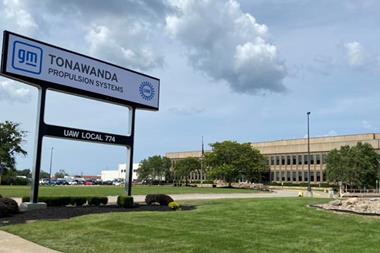
Addressing risks within your automation infrastructure can help protect your operations and reputation
By Larry Smentowski, senior industry consultant, automotive and tire, Rockwell Automation
EN EMEA Jaguar Land Rover HANNOVER MESSE
Built with Rockwell Automation and Cisco Technology and demonstrating validated scalable and secure network architectures where data is managed to improve business performance, the Jaguar F-PACE is a connected car that links seamlessly to your mobile devices.
In automotive manufacturing operations, risks that go unaddressed can lead to missed production targets, safety incidents and vehicle recalls.
Safety hazards, ageing assets and security threats can negatively impact your business, including your employees, revenue, plants, intellectual property, vehicle quality and customers. They also risk tarnishing your company’s brand and reputation – potentially to the point where they erode customer trust or loyalty.
To prevent risks from reaching this point, your risk-management efforts should focus where many problems can be controlled: your industrial automation infrastructure. You can help improve risk management by setting your sights on four key areas: safety, quality, obsolescence and security.
Safety: Focus on the Three Cs
While industrial safety is vital in any automotive operation, it’s often viewed as a costly burden, at odds with productivity. That doesn’t need to be the case. Best-in-class manufacturers, defined as the top 20% of aggregate performance scorers, have been found to achieve higher OEE and less unscheduled downtime while experiencing less than half the injury rate of average performers, according to Aberdeen Group research. Top performers also experience far fewer workplace accidents than average performers – to the tune of one in 2,000 employees versus one in 111 employees.
So, what are best-in-class manufacturers doing to excel in operational excellence and safety? They share a common set of best practices that can be grouped into three core pillars – or the three Cs – of an industrial safety programme:1. Culture (behavioural)2. Compliance (procedural)3. Capital (technical)
Of course, it’s not enough to merely focus on these pillars. You should strive for peak performance in each of them.
From a capital standpoint, for example, too many carmakers today are forced to shut down machines for safety reasons if a problem occurs on the line. In certain instances, however, contemporary safety technologies can be used to keep a machine running at a designated safe speed even when the safety door is open.
To see where your automotive manufacturing operations stand in each of the three safety pillars, consider using a free, online self-guided assessment tool, such as Rockwell Automations' Safety Maturity Index.

Quality: get better visibility with MES
Quality can never be sacrificed, even as production targets increase and workforces turn over. Amid these changes, one of the best ways to maintain quality is with real-time information visibility.
Modern manufacturing execution system (MES) software can harness the data that has long been buried in your operations to help you improve quality management and reduce process variability. For example, it can capture data on process results, defects and attributes to help you support key requirements, such as visual defect tracking, statistical process control and root-cause analysis.
Genealogy and track-and-trace applications in an MES also can give you new insights into your processes, production events and quality information. The applications offer forward and backward traceability to identify upstream or downstream quality issues. They can also provide product-location and as-built data to help limit the scope of recalls.
Beyond data collection, an MES with an error-proofing application allows you to create enforceable workflows. This can help verify workers consistently build vehicle assemblies and subassemblies to specification, and help improve your first-pass quality.Should errors occur on the production line, MES hold-and-quarantine capabilities can be used to manage affected vehicles. This supports the ISO 9001 and TS16949 automotive quality initiatives. Ultimately, it could help prevent defective and potentially dangerous vehicles from leaving your production facilities and reaching customers.
Manufacturing-process quality control was a priority for Guangzhou Automobile Group, one of China's top 10 automakers, when it implemented a modern MES.
The company uses its MES to perform defect control, and to carry out inspections and verification of quality issues. The MES also collects key component numbers and binds them with vehicle numbers, forming a genealogy record for every vehicle to help confirm they are produced up to standard.
Obsolescence: assess your assets, identify risks
Equipment and software obsolescence can result in downtime and lost productivity.
The best way to tackle obsolescence is with proactive life-cycle management. This includes working to identify obsolescence risks that exist today, as well as planning to facilitate easier maintainability of legacy equipment and access to spare parts.
The best place to begin is with an assessment of your assets. Many companies attempt to do this on their own, only to discover the cost. They sacrifice an experienced engineer for several months simply to collect a baseline of hardware and software information for a single plant.
An installed base evaluation (IBE) service is often much more efficient. It can collect and aggregate hardware and software data across multiple plants in just a few weeks. What’s more, IBE services also provide reports that offer guidance on where critical risks exist. A software inventory, for example, could help you uncover potential compatibility risks between firmware and software versions as you connect systems or update devices.
The findings from these activities can then be shared across multiple functions. Maintenance personnel, for example, could receive a report comparing installed equipment versus storeroom inventory to improve spare-parts management.
 Daimler Trucks North America
Daimler Trucks North AmericaSecurity: go in-depth
Being more connected requires the ability to get your data to and from machines and people – at every level, in any location and in the right context – in a secure manner. You can achieve this with three key steps.
First, conduct a security assessment to understand your risks and vulnerabilities, and to identify the mitigation techniques needed to help bring your operations to an acceptable risk state.
Second, adopt a defense-in-depth (DiD) security approach. DiD security establishes multiple layers of protection by addressing security at six different levels: policy, physical, network, computer, application and device.
Finally, work with trusted vendors that share your security goals. Before selecting vendors, request disclosure of their security policies and practices. Vendors should be taking steps to address security within their own operations, such as providing security training to employees, and in the products they supply to you.
As you go through these steps, don’t forget to leverage industry resources for help. Daimler Trucks North America, for example, used aspects of the Converged Plantwide Ethernet (CPwE) validated design guides from Cisco and Rockwell Automation for its network architecture design and deployment. This helped the company create a converged, plant-to-business network that provides secure and reliable connectivity across the shop floor and in office areas.
The power of prevention
You may not be able to stop every problem in your automotive operations. But you can reduce the likelihood of them occurring and disrupting your automotive operations by focusing your risk-management efforts on where those risks originate. Proactively leveraging existing investments and infrastructure will help you better protect your people, brand and business performance.
- Safety Maturity Index is a trademark of Rockwell Automation Inc.









































